#osha meta
Explore tagged Tumblr posts
Text
It’s remarkable how Sol keeps justifying his murder of Mother Aniseya sixteen years after it happened. He needs himself to be right, needs Osha to require saving, because it’s the only instance that allows him to walk away without a stain on his conscience.
Granted he feels guilty about murdering his padawan’s mom, but it would be so interesting to see what was going on in Sol’s head in the heat of the moment. Was it his “deep connection” to Osha that he believed was going to lead her to becoming his padawan? Did that influence his view on whether Aniseya was really a threat to Osha? Because she says it as she’s dying - she tells Sol she was going to let Osha go, and Sol can’t have that be true because if it is then what he did wasn’t in the defence of the innocent it was premeditated murder.
Sol can’t have it be true so he tells himself that it was a lie, that Osha was in danger, if not from Aniseya then from Mae, from Mother Korril, from everybody on Brendok because he needed her and believed with everything in him that she needed him too.
And for sixteen years he’s had the opportunity to recall that truth he buried so deep it never saw the light of day until they were back in Brendok. For sixteen years he’s lied to Osha and planted the seeds to destroy the potential relationship she had with the only other person who could have understood her. From her twin, her mirror, the other side of her coin.
So when Osha learns the truth, when she finds out just how much of her life has been a lie - how much of the past she was forbidden from healing from and grieving has been a lie. How the closest thing she has had to a father figure has spent every day of their relationship lying to her, she snaps.
And kills him.
#star wars#Star Wars the acolyte#the acolyte#the acolyte spoilers#osha the acolyte#osha and mae#osha Aniseya#Mae Aniseya#Mae the acolyte#qimir#qimir the stranger#osha#Mae#qimir the acolyte#oshamir#Sol#Sol and osha#Sol the Jedi#Sol the acolyte#the acolyte meta#Sol meta#sol the Jedi meta#osha meta#osha x qimir#mine
314 notes
·
View notes
Text
One thing I did appreciate is that The Acolyte did not hold back on that Osha went full dark side, that Sol's kyber crystal was crushed by her anger and hate to the point that it bled into a red saber. She straight up murdered someone who was not fighting back. She killed him because she was hurt and angry, not because he was a threat. Osha's feelings of betrayal and rage were valid, her actions were not. She murdered an unarmed man who was not fighting back, who had no intention of fighting back, who literally forgave her as she choked the life out of him, and nothing of her actions were justified. She wasn't even regretful about it. The dark side can be humanized to a degree, it always has been in Star Wars, that's nothing new. Anakin's everything ever, Maul's pain and desperation for a connection through an apprentice, Dooku's clinging to his care for people like Yaddle or Asajj, the dark side has never been about detached or unsympathetic anger. It's always come from a very human place, that's why the Jedi constantly caution that no one is beyond it. But Osha embraced it here, she stepped over the line and murdered a defenseless man because of her rage, not because it was in any way justified as a killing, and the kyber crystal screamed and bled because of it. You don't get a red saber by being justified, you get it by crossing the line into an act of evil. And props to The Acolyte for not shying away from that, as human as Osha is and will continue to be, her actions were over the line of evil.
3K notes
·
View notes
Text
Choosing the Beast: Modern Folklore Heroines Embrace the Animal Husband

“I choose the bear.” The refrain rang out across the web, with many a woman nodding in agreement or at least understanding, and certain men huffing with indignant outrage. Just a meme, really, but did it speak to a deeper truth? Is it merely age-old mistrust of patriarchy talking, or a true desire for the beastly, the wild, the untame?
I’m no sociologist, of course, but I have noticed an emerging trend in fem-gaze media that seems to reflect this view. In movies like I Am Dragon (2015) and recent shows like My Lady Jane and The Acolyte, the heroine chooses the beast, loving her animal husband in his wild form rather than requiring him to transform back into a mundane man to earn her affection. This is such a departure from the typical folktale pattern that it’s difficult to even find an historic example where this occurs.
Commonly thought to reveal the desire to tame a dangerous mate in a patriarchal society, most animal husband tales (ATU 425a) feature a hero who ultimately transforms permanently into a human. This is viewed not only as freeing him from the maddening effect of his wild form, but also saving his bride from committing the sin of bestiality. In these tales, the animal mate’s transformation is necessary for the salvation of both.
Is the modern heroine then damned by choosing her husband’s beastly form? Or does she actually free them both from the yoke of patriarchal expectations?
Bathing: Discovering the Wild Masculine
The first motif that stands out in these modern screen examples is bathing. In animal spouse tales, there is often a dynamic of the hunter and the hunted, and thus a moment when the hunter comes upon their would-be lover unawares. Perhaps they find the animal spouse sleeping, or they cast a light on them unexpectedly, see them without their animal skin or disguise, and so on. And of course, they often come upon the lover at their bath.
There is an implied eroticism in this discovery, finding one’s quarry not only undressed, but also in the most private of activities. Water of course symbolizes fertility, but bathing is also purifying, symbolically washing away all that might make a mate undesirable. And this, perhaps, is the reason that historically this motif is used almost exclusively for animal brides, not animal husbands.
For the animal husband, he either actively chooses to reveal himself to the bride (perhaps on their wedding night), or she violently strips away his disguise, often armed with “flame and steel” like Psyche and her many avatars. Animal brides on the other hand are nearly always discovered at a body of water, bathing. The hunter will then capture her either by stealing her animal skin or cloak, or by placing his own clothing on her. What does it mean, then, when it is the husband who is discovered bathing in a body of water, held as an erotic object in the feminine gaze?

In The Acolyte, Osha follows Qimir to a pool where he slowly undresses, in full knowledge that she is watching. On the shore, she steals his lightsaber, just like the hunter who steals the animal skin, symbolically claiming him. When he emerges, Qimir dons new clothes, as if acknowledging that he is a different person than before he entered the water, almost purified in a way. Osha is forced to confront that there is more to the murderer in the mask than she realized.
Similarly, in My Lady Jane, our heroine goes looking for Guildford just before sunrise on their ill-fated wedding night, only to discover him bathing in the stables. The scene is gratuitously filmed from Jane’s (very horny) perspective, flipping the script on the countless scenes in screen history shot with the masculine gaze. Immediately after she discovers and confronts him, Guildford transforms against his will into a horse, and Jane realizes that he is an Ethian, a creature she has been taught is demonic and unnatural.

And in I Am Dragon, Mira makes several discoveries in quick succession: first, she deduces that Arman is actually the dragon. In the next moment, she slips from the island’s peak and falls, saved only when Arman transforms at the last moment and breaks her fall with his dragon form. The water begins to wash over his unconscious body, and at first Mira thinks that she will allow him to drown. But the sight of Arman in his human form after he rescued her, worried over by his animal familiar, stirs her to pity and she wraps him in a sail and drags him to safety. In this way, she clothes him, claiming him as her own.
Each of these heroines discovered a new aspect of her husband at the bath, finding him unexpectedly alluring, and ultimately choosing to begrudgingly claim him. Each animal husband tried to wash away his beastly form, to separate himself from the wild masculine. These men feel a sense of disassociation from a part of themselves, but now that their brides have discovered it, there will be no more hiding. Further, the bride now holds the power in the relationship, evidenced by how her husband needs her: Qimir needs Osha to be his apprentice, Guildford needs Jane to help him “break the curse,” and Arman needs Mira to heal him from his wounds.
Playing House: The Half-Husband
The second feature of these stories is a period of domesticity for the couple. For a brief time after the husband’s beastly nature is revealed, the lovers “play house” like children. While sexual tension is present, they typically do not consummate their union during this time, but instead cook, eat, rest, and care for one another. What’s more, they ignore or even attempt to actively destroy the husband’s animal form. They deny that this is part of him and therefore part of their relationship.
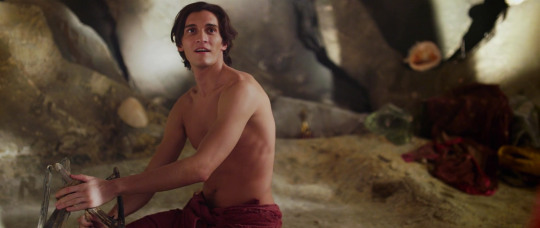
In I Am Dragon, Mira heals Arman, and wakes the next morning to find he has left food for her (dragonfruit, appropriately). Together they begin building a home out of shipwreck debris they find scattered around the island. A cheery montage shows them decorating a living space, choosing clothes, playing music, and dancing. But the specter of Arman’s monstrous form lurks on the edge of their idyllic life. Mira has nightmares, and tells Arman how much she fears “the dragon,” notably not referring to them as the same person. And eventually, it emerges that Mira has been planning to escape, rejecting Arman’s dragon form entirely.
After he sheds the helmet and robes of The Stranger, Qimir turns his attention to caring for Osha: he heals her, lets her sleep in his bed, provides clothes, and cooks for her. In turn, after some lightsaber-wielding, Osha becomes more comfortable in his home and accepts the food he offers, eventually even trying on his helmet. Later, they bicker amiably on their way to Brendok, like an old married couple on a road trip. When not facing down Jedi, Qimir leaves his menacing persona behind and transforms into an empathetic, protective, and alluring partner.

Jane Grey, meanwhile, finds herself using her honeymoon sequestered away in a private cottage to try to cure Guildford of his Ethianism. With her knowledge of medicine, she concocts various potions and magical cures, but none of them succeed. Guildford often checks in on her after these disappointments, making sure she’s getting enough sleep and taking care of herself. It’s also clear that they’ve been regularly dining together when Jane suddenly dashes off to rescue her friend. Guildford follows her and the two protect one another, followed by an almost-tryst. Even when they move into the palace, their day-to-day (or rather night-to-night) life is one of comfortable domesticity, although they continue to deny Guildford’s horse form.
In each of these cases (although less so in The Acolyte without Season 2 to continue the story), playing house can only last for so long while the husband’s animal nature is denied. There is a part of him that is suppressed, rejected, and this leads to him being incomplete, a half-husband. Each hero is unable or unwilling to accept and celebrate his whole self with his bride. Eventually, it is that denial that leads to a rift between the couple, which can only be healed not with the transformation of the husband, but with the embrace of his animal form.
Enforcing Patriarchy: The Rival
Each of these relationships exists in direct opposition to the dominant culture in the story: Arman as the Dragon is the literal enemy of Mira’s people, Qimir as Sith is the enemy of Osha’s Jedi masters, and in My Lady Jane, intermarriage between humans and Ethians is punishable by death. By choosing to stay with their animal husbands, even for a brief time, our heroines are openly defying the patriarchal norms of their societies. But no oppressive society is about to take that transgression lying down. In each story, a rival emerges to enforce the patriarchal order, kill the beastly husband, and retrieve the bride.

In I Am Dragon, Mira’s betrothed and descendent of the dragon-slayer, Igor, journeys to rescue her from the dragon. Over the course of the story, it becomes clear that Igor cares nothing for Mira herself, and merely feels entitled to her as his bride. Dragon-slaying is his heritage, so he must find her, kill the dragon, and take his place as the hero of his people. Even the marriage ceremony illustrates his ownership of her: he takes hold of a rope tied to her boat and reels her in, thus binding her to the patriarchal order. Contrast that to Arman, who offers her the power of flight, a symbol for freedom.
In Osha’s case, Qimir’s rival for her loyalty is clearly Master Sol, who wants to keep his former pupil dependent on him and the Jedi. Sol takes patronizing fatherliness to an extreme, constantly rescuing Osha rather than letting her stand for herself, teaching her to deny her feelings and instincts, and lying to her to “protect” her. The Jedi refuse to allow that there might be any other way to access the Force than their own, thus invading the home of the Brendok witches and ultimately orphaning the twins. Sol continues to press this dominance to the end, challenging Qimir and insisting to Osha that his own lies were justified.

In My Lady Jane, there are two rivals, both women. Lady Frances attempts throughout the show to dominate her daughters and crush their wills, forcing them into unwanted marriages, applying political pressure, and even counseling Jane to abandon Guildford to save herself. The other rival is Mary Tudor, who is determined not only to emulate her father’s violent, oppressive, and misogynistic reign, but to crush anyone she considers “unnatural” or who poses a threat to her rule. These characters stand as clear examples of how women can enforce patriarchy, too.
In each story, there is a moment when the rival briefly recaptures or “rescues” the bride from her beastly husband, bringing her to a moment of decision: will she stay within the bounds of patriarchy like a good little girl? Or will she make an act of defiance to choose her own path?
Marriage: Choosing the Beast
The bride’s choice will ultimately decide not only her fate, but that of her mate as well. As an independent character, the wild masculine is deeply wounded, separated from himself and thus from his bride. He longs to transform not into a greater, more whole person, but into a lesser, half-person. Alone, without the embrace of his anima, he cannot see the value of his beastly form. Instead of healing, he faces annihilation.
As a part of the bride’s psyche, the beastly husband represents her innermost desires, the truth of her heart, and a spirit freed from the expectations of her society. He is her animus, her missing wild masculine. If she transforms him into a man, then she will tame his wild nature, bringing him to heel under the boot of the patriarchy. Choosing the human form and rejecting the beast means rejecting her own psychological needs. It would be just another form of psychic dismemberment.

Fortunately and unusually, each of these modern brides chooses her beastly husband without demanding he transform. When Osha finally agrees to become Qimir’s apprentice, she takes his hand under the willow tree, clasping the newly-bled lightsaber between them. A few scenes later, this wedding imagery is repeated when they hold hands over the saber again, this time looking into a sunrise/set. Notably, at the moment they “marry” under the willow tree, Qimir is wearing his beastly helmet with rows of menacing, wolfish teeth. He has not come to the light side or shed his Dark Side persona, but Osha has embraced him anyway without fear. And while they might not both be healed (yet), they are more whole together than they were apart.
When her efforts to cure Guildford of his Ethianism repeatedly fail, Jane begins to suspect that his “condition” cannot be cured at all. But listening to her Ethian friends Susanna and Archer finally convinces her that the truth is Guildford doesn’t NEED to be healed - being an Ethian is who he is, and it’s nothing to fear. Unfortunately, Guildford still associates his beastly form with his mother’s death, so he is unable to accept it as Jane encourages, and flees. After a near-death experience, he uses his equine speed to return to the castle just as Jane is deposed and captured. As our heroes battle toward the end, Guildford comes to learn that there are many other proud Ethians, and that his family loves and accepts him in any form.
Still, he’s unable to transform at will, and when Mary captures him and sentences both husband and wife to death, it seems their story may end in tragedy. But as Guildford has been struggling to accept himself, Jane too has been battling with her own conscience. Does she renounce Guildford to save herself? Use her wits to kill the guard and escape? Bend to her mother’s manipulation? Jane confronts each temptation, and ultimately chooses to face death rather than betray Guildford or herself. But when her Ethian friends (the wild instinct) appear to disrupt the execution, our heroine seizes the opportunity to rescue Guildford. Unable to free him from the burning pyre, she confesses her love for him, and they kiss amid the flames.

Fire is often a herald of transformation, burning away illusions to reveal the truth. And when Jane and Guildford exchange their vows in this symbolic marriage ceremony, Guildford’s fears and illusions are finally burned away. Now that his bride has accepted his beastly form, he can accept it too, and so he at last transforms at will into a horse so that they can escape. Their story ends with them married and whole before the sunrise.
Among our modern heroines, Mira is the boldest in her embrace of the beastly husband. Offered yet again as a bride to Igor, she realizes that this is not what she wants, and casts off the tether from her boat. She declares “I love the Dragon!” using the name of her husband’s animal form rather than his human name. Then, she sings the song that will call the dragon to her, and he appears to carry her away again.
But their story is not over yet! Earlier in the story, Arman told Mira of how he loses control when in dragon form, and that dragons are compelled to reproduce by burning maidens to death and retrieving their offspring from the ashes. Returning to the island with her a second time, the dragon drops her on the altar and prepares to spew fire, but Mira lunges up and kisses him. This act of love, even when he is a monster, stuns the beastly husband. Again, Mira declares her love and kneels before him, saying she does not wish to be parted. We might expect the animal husband to transform in this moment, but instead he lays his fearsome head in her lap as a lover. Their story ends with a child and a flight in the sky, silhouetted by the sun just like the other couples.

Each bride, when confronted with the option to return to the patriarchal limits of her childhood, chose instead an act of love and acceptance for her wild masculine. This embrace helped the beastly husband to accept his whole self, and he is healed without having to cut off the wild parts of himself.
What Does It Mean?
Again, this story is so rare in world folklore that it’s difficult to even find examples. On fleeting occasions that the woman chooses an untransformed beast, it is presented as a cautionary tale. These women are framed as a danger to the community for their bestial impulses and abandonment of the social order, much like witches who were said to consort with the devil. It was certainly never presented as a happy ending, insofar as we can tell from written accounts.
So what does the emergence of this tale mean for our culture? I would argue that this is just the latest step in our ongoing reckoning with historic gender roles, as well as renegotiating with other forms of systemic oppression. People of all genders are pressured to reject a part of ourselves, cutting us off from our own truth and desires that run counter to the enforced social order. We must not challenge patriarchy, must not embrace different gender expressions, must not blur established hierarchies of power, must not find joy and power in our identities, and so on.
This enforced denial does tremendous damage to everyone caught in the system, and so through story, we dream our way to escape. We dream of embracing the dark, wild parts of ourselves, of flying free on a spaceship or a dragon or enchanted horseback, and of being totally loved for who we are.
It’s clear patriarchy is still fighting back against this emancipation of the wild feminine and wild masculine, given that both The Acolyte and My Lady Jane were canceled not long after their release. In the case of The Acolyte in particular, there was a sustained campaign from its announcement to harass and silence the creators. Demoralizing as this phenomenon may be, it’s important to remember WHO ultimately owns these stories:
“Fanfiction is a way of the culture repairing the damage done in a system where contemporary myths are owned by corporations instead of owned by the folk.
-Henry Jenkins, NYT 1997
Ah, an oldie-but-goodie. But Dr. Jenkins is right. Corporations may greenlight, film, release, and then cancel these stories, but ultimately they belong to the people. We take from these tales what speaks to us, leave what does not, and then retell them ourselves in fanfiction, in art inspired by the stories, and in lessons we pass on to our friends and families. If the embrace of the wild masculine speaks to you, let the story take root in your own life. Do you know someone who needs to be embraced, just as they are? Do you need to accept the parts of yourself that society tells you to hate? Do you want to be free, healed, and whole?
If so, then let these stories show you how, and tell more like them. Embrace the beast, and find your joy.
Sources:
Beauty and the Beast Tales From Around the World by Heidi Anne Heiner
In Search of the Swan Maiden: A Narrative on Folklore and Gender by Barbara Fass Leavy
And a relevant song for you, as a treat:
Women Who Run With the Wolves: Myths and Stories of the Wild Woman Archetype by Clarissa Pinkola Estés, Ph.D.
youtube
#monster husband#animal husband#atu 425a#the acolyte#oshamir#the acolyte meta#star wars#star wars meta#oshamir meta#osha x qimir#osha aniseya#qimir#master sol#my lady jane#lady jane grey#jane grey#guildford dudley#jane x guildford#janeford#on drakon#i am dragon#he's a dragon#i am dragon 2015#mira x arman#beauty and the beast#folk tales#fairy tales#anti patriarchy#save the acolyte#save my lady jane
657 notes
·
View notes
Text
“it doesn’t make sense for osha to forgive qimir so quickly. its terrible writing.”
who said she forgave him? we can have complex feelings for people. stop being so boring. she realized the jedi and the man she considered a father had been lying to her for sixteen years. the man who framed her sister and was complicit in the destruction of her coven. he did not once apologize but instead tried to justify his actions. after having her entire belief system shattered, she lashed out in anger.
she joined qimir in exchange for her sister’s life and because she’s curious about the other side of the force. from amandla’s recent interview, osha has never been manipulated in the choices she’s made. her decisions are hers and hers alone
#leonna.txt#the acolyte#star wars#osha x qimir#oshamir#sw meta#meta#i don’t think qimir would want to be forgiven that easily either#anger is encouraged. nearly every sith has hated and wanted to replace their master#she knows exactly what kind of person he is#and she was upset over yord and jecki#but let’s be honest. she lost whatever kind of relationship she had with yord and she knew jecki for like five minutes#amandla stenberg#manny jacinto
466 notes
·
View notes
Text
The red flags are so blatant in what we see of Mother Aniseya’s coven, is it not registering for anyone else that Sol got too emotionally involved but his instincts might have been correct?
Mae and Osha don’t know anyone but this small community. No other children, no friends. Apparently they’re not even supposed to venture outside by themselves. They don’t have their own lives, brought up to basically think of themselves as one person.
Aniseya’s the only one who truly loves them and cares about Osha’s feelings. When everyone’s discussing her leaving, the others only talk about what it will mean for them and their future. They just want her power.
Aniseya singles out the youngest of the Jedi to control with her magic as a threat when they haven’t done anything hostile. It’s understandable they feel a bit threatened and I see why the Council says they overstepped, but Koril is ready from the time they show up to go to their camp and kill them all.
Why are they teaching the girls to fight like it’s so serious? If these women all just want to live here unbothered, what are they actually preparing them for? What was it going to mean when the ritual was completed with both of them, and was it going to do something irreversible?
Aniseya tells Osha that others don’t accept their ways so she wouldn’t like the outside world like she thinks. (A manipulation tactic in cults.) But with the Jedi’s perspective, it’s now clear everything they said when they interrupted the ceremony was basically a pretense for checking on the welfare of the girls and they don’t care about these witches practicing another Force-based religion or training kids. So if they’ve got this persecution complex it could certainly be because they’re actually doing something wrong. (Or just because they want to keep the power of this vergence all to themselves, all while saying they’re not like other girls 'cause to them the Force isn’t something you use or own.)
Most alarmingly once Aniseya’s dead, none of them try to get to the children in the burning building. They just keep attacking the Jedi for what they did.
Of course lots of viewers will say that many of these concerning things are problems with how the Jedi treat children, too. And that’s probably meant to be the point, that there are different ways of looking at it. But it’s telling how practically nobody’s even addressing them. This show certainly reads differently depending on the bias you come to it with.
And none of these things really give the Jedi the right to remove these children from their family. I don’t think Sol’s concern comes from nowhere, but whether Osha's safe here is a separate question from whether she should be a Jedi and not necessarily in their purview. But he’s not using clear judgment because of his feelings so he ends up just hurting Osha, surely worse than anything her own mother was going to put her through. Attachment is selfish love, it's not good actually!
454 notes
·
View notes
Text
Qimir consistently aches to see the pain the dark side causes Osha and I believe this will lead him to resist Plagueis' plans in s2.
His first moment of regret and resistance is, in fact, at the very completion of his seduction! He gets Osha to put the helmet on - and it hurts her. It's causing her pain, so he fights to rescue her from that. Even though, presumably, this was (with Plagueis, whether knowingly or unknowingly) the goal.

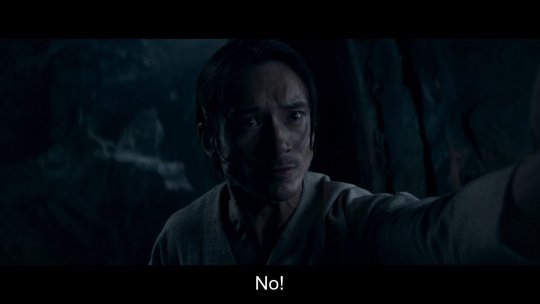
Let's backtrack a second and reflect on the seduction itself. The show creator/lead writer, Leslye Headland, has said that it wasn't manipulation on Qimir's part, that he meant everything he said. Two relevant quotes from the same interview with her on this point:
"So, in my opinion, Osha is extremely in denial about her own anger at the Jedi and at her father, i.e. Sol. She's in extreme denial about that because she feels like she's not allowed to be angry, and she's in an enormous amount of pain over her sister and their history, and she also feels like she's not allowed to feel that. So, someone coming in and saying, “Actually, feeling all those things is not only okay but actually could restore your spiritual foundation,” is almost too much. I don't think that's manipulation. I think he's telling her the truth."
"[T]he relationship between Lo and Jen in Crouching Tiger, Hidden Dragon was an influence in the writer's room. We referenced that relationship over and over again. The intentional parallel is that they are equals and their relationship is earned through mutual vulnerability, not intimidation or manipulation."
However, someone can be themselves misled and so mislead you too, from a place of sincerity! That is, perhaps, the most heartbreaking way of all to mislead someone. Qimir is lost - the Jedi path damaged him and he (like so many Jedi before him) snapped to the Sith path. It's not working for him, it's causing him pain likely, but he believes it and shares from that place. But the moment Qimir sees this path is causing Osha pain, he feels compelled to do something to help her.
Once he gets the helmet off Osha, Qimir seems relieved when he learns the vision Osha *thinks* she saw, of Mae "killing a Jedi without a weapon." (Which Qimir somehow knows is the goal here - to get Mae or Osha to fall - presumably because Plagueis either gave him the vision or told him directly to try to get that to happen?)
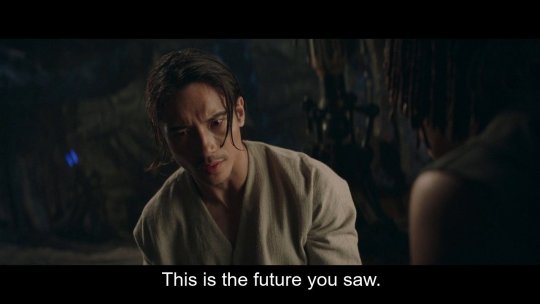

He's content with the idea that Mae will be the one to do it, fulfilling the vision/directive, and actively seeks to make it happen from this point on. He tries to talk her up into doing it at the pivotal moment, but that's not what she's about, her feelings about Sol are not so out of balance for her to "fall" as the Jedi and Sith understand it. She feels anger but also wants justice most, not revenge.

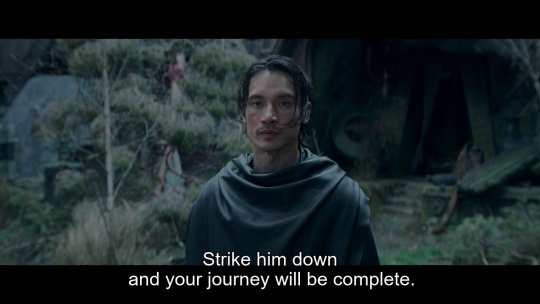
I read disappointment in how Manny plays his reaction to Mae's "No" - disappointment at "failing" sure but also I think it's related to the fact that he wanted it to be Mae, not Osha.
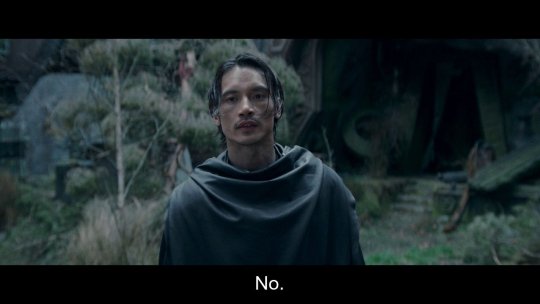
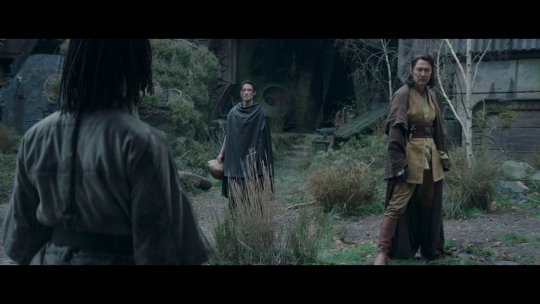
This was cemented for me by the way he played Qimir's reaction to Osha's fall. He's not celebratory, though he's just accomplished what he had been trying to since he began teaching Mae! He seems stricken, actually. There's no pleasure or satisfaction in his "success"! Witnessing Osha's pain only makes him feel compassion and bow his head in sorrow. This "success" is ashes in his mouth.
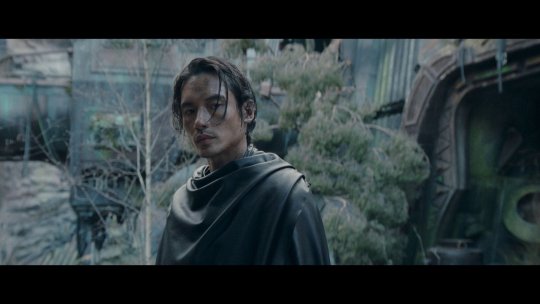

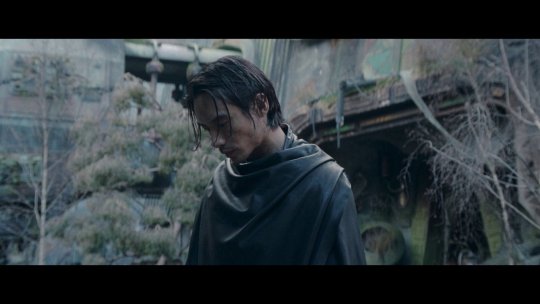

As a mutual on Twitter pointed out to me (♥️_LokiDokie!), Leslye's commentary in this interview supports this reading of Qimir as grief-stricken by what he's seen:
"Then it's like this passing through, stepping over the threshold, that actually will bring them closer together, which is so interesting. But the motivation I gave to Manny in that moment — in theater, we would call it dramaturgically — for, “Why is he stepping over to do that,” because it said it in the script, was, “You have been in this position. If you have a red lightsaber, you have felt this level of despair, rage, and dejection. So go over there and let her know that you have had that experience.” And he just did that beautiful thing. I was like, “Jesus Christ.”"
His reaction is a stark contrast to Mae, who never fell to the dark side, and doesn't understand what she's seeing - she mistakes this for Osha being liberated from Jedi mindwashing. THIS is what Qimir's face would look like if he thought this was a good thing and was happy about it:

The contrast is quite stark.
Qimir's sorrow for Osha continues as he attempts to comfort her and then sees she's bled the saber.
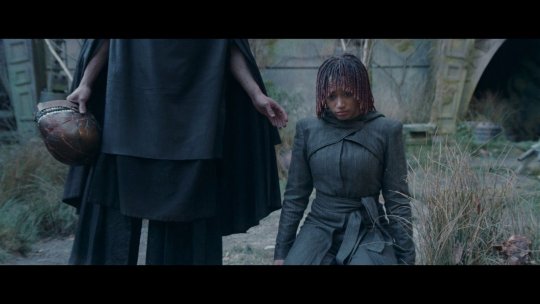


Intriguingly, Qimir has the helmet on and is "hiding" emotionally when he wipes Mae's memory. We don't get to see how that pain effects him. But the pattern throughout the episode is that when Osha hurts he aches too.
In the final scene, Qimir approaches Osha, again, without triumph at any of this. He's gotten everything he thought he wanted, but he looks at her and I read concern, sorrow, wariness.
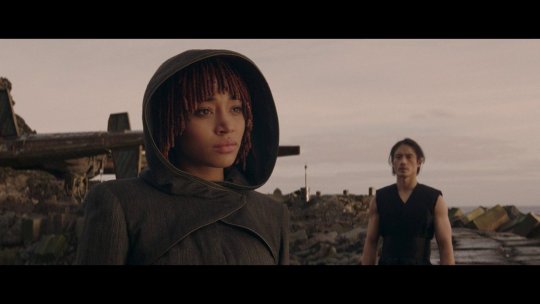

He steps closer to her and takes her hand supportively, continuing his pattern (3 times in this episode!) of physically coming close to help/comfort her when she's hurting.
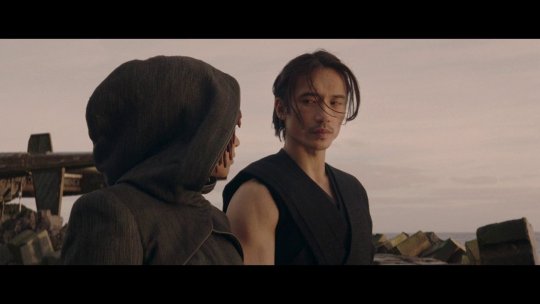
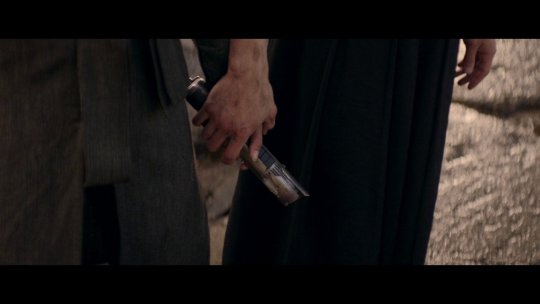
Then he raises his chin with resolve, but no happiness. They are facing the future, but they are "doomed" on the Sith path. Romantic love cannot live there anymore than it can thrive on the arid, repressed Jedi path. I think he suspects that - whether or not he's knowingly in league with Plagueis. Whatever is coming, the Sith path can only cause Osha more and more pain...


He cannot help but ache with her when he sees Osha in pain and want to help her. I cannot imagine an s2 where they continue down the Sith path without him breaking under the strain of watching the pain it causes her - he could endure it himself but seeing her do it? He'll snap. And that romantic love--something BOTH the Jedi and Sith reject and denigrate--that will help them escape imo. Here's a quote from Leslye I interpret as supportive of this reading. She references how the Sith path is inimical to romantic love and then alludes to the tantalizing possibility of escape:
HEADLAND: Oh, yeah! Again, they’re Sith. It's a different vibe. To me, it's gonna hit different because of their allegiance and who they are. So, yes, it is framed as romantic, but I do think, again, it's not gonna turn out great. I think if he's training her, “One to hold the power, one to crave it.” So they're starting off as equals, but what's gonna happen? Like in Romeo and Juliet, it's amazing because right at the beginning they're like, “Okay, these two die. Let's start the play.” As you're watching this incredible love story unfold, and it's one of the most beautifully iconic plays ever written, in the back of your mind, you're like, “This is not going to turn out well.” I want to clarify: They are not necessarily doomed or destined to fail as a team. But the Sith rule of two denotes a power imbalance. Which clearly, due to the final shot, is not their relationship. Also, Plagueis complicates their journey as Sith, because we know his apprentice is eventually Palpatine. They will not defeat him.
I feel pretty confident that the love he feels for her is pivotal to their journey away from the Sith path and what Plagueis wants for Osha - both because Leslye knows this is not a good path and because of the deep sense of care and connection Qimir already feels for Osha.
Combine this with Leslye's comments and imo it being unlikely that they'll repeat the same pattern with Qimir & Vernestra that they did with Sol & Osha and just the overall "sameness" that would come of hammering the endless cycle in more and I just don't buy that as the direction we're headed.
It is possible to tell it as a relentless tragedy and keep hammering the endless, inescapable cycles but, while tragedies are valid (I enjoy hotd!), even they have a narrative form more varied than that usually. And this IS a "coming of age" psychological/mythic Star Wars story at the end of the day. And one Leslye (happily gay married with a child!) drew on her own experiences (with religious trauma) to write... she didn't end up trapped in darkness why would a young protagonist like Osha have to?
Here's the full Leslye quote about religious trauma, since I believe it's vital to understanding where she and the writing team are going to take Osha, Mae, and Qimir:
You have a play, Cult of Love, coming to Broadway this fall. It’s about a Christian family gathering for the holidays. It’s inspired by your own experiences with your family. You were working on it at the same time as The Acolyte, from what I can tell. Did they influence each other? Our director, Trip Cullman, and I were talking about how it’s called Cult of Love because all cults have a dream, and the dream is really beautiful. Even Jim Jones started out trying to desegregate Indianapolis. This family in the play has this dream that they follow to the logical conclusion, which is that they never achieve it. I was raised Christian. Christianity is the ultimate dream. It’s a beautiful concept that God becomes human in order to love you more. Then you look at what Christianity has done to the world: colonization, genocide. It was a beautiful dream that doesn’t justify the human action that comes along. The Jedi also live in a dream, a dream they believe everybody has. In The Acolyte, the pilot ends with the line “An acolyte kills the dream.” The drama is to wake up to the fact that the dream doesn’t exist.
I think the point is for Osha and Qimir to wake up to the fact that both the Jedi and Sith "dreams" do not exist. They are toxic mirrors of each other - and Osha and Mae were born into a culture (the culture of the Coven and their mothers) that didn't see the force in the binary way the Jedi&Sith both do. Mae, who remembered and kept to the pov of the Coven, never fell to the dark side in a Sith way --she felt anger but balanced with a desire for justice, even when she killed-- it was only her sister, taught repression and self-denial by the Jedi, who did. Qimir and Osha have a conceptual/spiritual escape route open to them if they wish to use it.
Finally, Leslye has said that she's written Qimir as her "shadow" (in the Jungian sense) and that she feels close to him - and what does he want? "I want freedom." I don't think someone driven by that desire is going to just surrender himself AND the woman he loves to Plagueis the Creeper.
My wife was like, “What do you want to say?” I was like, “I wanna say that people don't want me to exist as a gay woman, as a woman in this particular space, working in this wild sandbox.” There was a whole crew of people who believed in me, but deep down, I felt like, “I am unaccepted for who I am because of what I believe in and wanting to wield my power the way I'd like without having to answer to the legion of people that just exist out there.” By the way, I think everybody feels this way. I think that's why it resonates when you're honest about yourself, and you get personal about it. When he says, “I want freedom,” that's what I want. I just want freedom. I want to be able to just be out there and be myself and be the type of artist I want to be without having to answer to anybody. That's why I feel so close to him.
370 notes
·
View notes
Text
It's been years, but I'm back on my Star Wars shit.
I think the thing I love most about Oshamir as a ship is how much of a female power fantasy it is, and the show unapologetically leans into that aspect.
Like, Qimir as an undeniably powerful and dangerous man, but he very rapidly started shifting into the more submissive person in the relationship.
He's not a tyrant or a fascist or a warlord or anything like that which could be triggering and icky. He's a lone wolf committed to his own freedom and making his own path as he sees fit. He's a killer, but only when those deaths either protect/defend his freedom and independence, or advance the cause of his power and his personal journey.
HOWEVER, bro is also clearly lonely and touch starved, and willing to take on fake personas in order to find something resembling friendship.
This is where the female power fantasy comes in.
The minute he meets Osha, he's so immediately taken with her that he drops his fake persona and nearly reveals himself. Then when he is ready to kill everyone else to protect himself, he goes out of his way to avoid killing Osha, flirts with her mid battle, keeps checking that she's paying attention when he's talking. The man is crushing on her big time. He even seems impressed every time she fights against him.
By the end of the battle, when he finds her unconscious in the forest, our boy is already halfway in love.
What better power fantasy could there be? Not only does the most deadly man in the galaxy not want to hurt her, but he's totally smitten when all she's done is point weapons at him.
The fantasy only gets more intoxicating from there. Not only does he tuck her into bed and tend her wound, this guy COOKS HER SOUP and respectfully sets up his makeshift bed across the room.
From the moment she picks up his lightsaber, Osha starts losing her fear of him, because it's obvious this dweeb is just peacocking by showing off his nice body and his artfully arranged tendrils of hair and flirting non stop.
The way he literally puts his life in her hands and remains unflinchingly honest and straightforward with her while helping her work through her complicated emotions is only icing on the cake. Not to mention he keeps inviting her to join him, but every time she rejects him he just quietly pouts and respectfully backs down.
I'm not going into detail about how he follows her around like a devoted puppy for the rest of the season while also respecting her personal boundaries.
The bottom line is: Leslye Headland created the ultimate female power fantasy by giving Osha an overpowered monster who instantly falls for her, willingly and eagerly defangs himself, devoted himself to her needs, and submits himself to her choices.
It's also perfectly clear that he can still transform into a monster, but now he's OSHA'S monster. And he's also Osha's biggest fanboy and her eager emotional support person.
Leslye just knows what the girlies like and served it up to us on a platter.
We are so fed. Now just hoping Disney has the guts to keep trying something new by giving us a second season.
#the acolyte#star wars acolyte#acolyte meta#oshamir#renew the acolyte#osha aniseya#qimir#female power fantasy#writing stuff
299 notes
·
View notes
Text
Ironically, contrary to what most of the angry YouTubers are saying, I think The Acolyte is a story that heavily focuses on lore.
(Well, not really "lore", more like "fanon.")
But my point is, it makes a lot of metatextual commentary about these fanon tropes and lore elements that fans debate about ("are the Jedi truly good? Is the Sith way really so bad if they allow you to feel?") but it completely forgets that all those elements were created in the first place because they were telling a story.

Example: how the Jedi approach emotions.
The Jedi control their emotions. They don't repress them.
They allow themselves to feel them, but they do their best to not let themselves be ruled by them. Sometimes they succeed, sometimes they fail, but they do their best.
This is because wielding the Force is based on emotions... you use it with compassion in your heart, you're on the Good Side, you use it with negativity and selfishness, in search of pleasure, and it leads you to the Dark Side.
This all then ties in to how Luke and Anakin approached the Force, how the former saved the galaxy because of his compassion,after the latter one doomed it because of his greed, etc. It's a metaphor for emotional regulation and teaching kids to be compassionate.
There's a reason this has all been laid out this way.
So when you're making a new story, and your narrative is that:
"The Jedi think they're controlling their emotions, but actually they're just repressing them, and at one point one of them will snap and kill them all..."
Well... no? That's not the story. Because the narrative of the Prequels clearly frames Anakin's selfishness as the cause, and that of the Original Trilogy clearly frames Luke's retreading of his father's path to darkness as a bad thing.
Same goes for:
"Osha frees herself from the shackles of her trauma by killing her father and joining the Dark Side."
Joining the Dark Side is portrayed as a bad thing, it's synonymous with losing yourself, not finding yourself. That's why Episode VI frames Luke not killing his Dad as a good thing.
So... are we just gonna ignore all that?

There's a narrative attached to these points, and you can either reject it or embrace it... but if you don't address it in some way, you're missing the point.
The same way that, if tomorrow I decide to join a soccer game, then pick the ball up and shoot a hoop, I'm missing the point. The ball is being kicked around for a reason, the game is soccer.
The Acolyte focuses on lore and fanon tropes too much... and forgets to even address what the story of Star Wars is.
292 notes
·
View notes
Text
the acolyte confirming mae and osha are 'technically' the same person and giving them opposite arcs (osha choosing the dark side by murdering sol in cold blood vs mae choosing the light side by letting her sister/her attachment go because it's what she wants/what will be 'best' for her) truly emphasizes star was' core message that no one is above the dark and everyone can be redeemed. they're the same person. it can go either way at any time. we can choose the dark at any point. we can choose the light at any point.
#i love when the themes are popping off#i do feel like the show suffered from the 8 eps format but i think the twins arc really worked for me. idk its neat.#im really curious to see where a s2 is gonna go#star wars#the acolyte#sw meta#osha aniseya#mae aniseya
286 notes
·
View notes
Text
Osha is Qimir’s salvation.
Crying out Sol’s name to arrest him from murdering Qimir instantly crystallized Osha’s position in Qimir’s life. The way that he singsongs her name like a prayer, almost in relief, the “I knew she was different” written all over his face? In that moment, she was his.
He doesn’t attempt to kill her in that entire fight, only to disarm- the exception being when she puts a literal target on his back. If he wanted to kill her, he could have. He doesn’t. He’s closer to killing Mae than Osha at each encounter. Their history, and her betrayal, incentivizes him not to protect her anymore. (I think that Qimir was acting to protect Mae in several ways, but more on that later.) Osha’s blind duty to protect his life- when really, she wanted to protect Sol- instantly attaches Qimir to her.
I’ve seen this floating around, and I agree- I think that Osha is going to become a caretaker to Qimir, a reason for him to live, a reason for him to abandon his death wish. She’s going to keep saving him. Her reasons will change- from being protective out of duty to being protective out of love.
I think that the scariest part will be when she can’t anymore, either by going too far to the Dark Side or something else. I don’t know how Qimir will react to that. I don’t know if he’ll get angry, resentful- perhaps he’ll self-harm in some way. All I know is that it would destroy him.
193 notes
·
View notes
Text
Not to be the first soldier on the frontless of the woobification of Qimir (he is a villain, we know this, and I love him for it), but the lack of nuance, or rather the one-dimensional angle people who don't like his relationship with Osha have taken with him, irks me so bad. I get it. He is Sith, right. Treachery is their way; and what are the darksiders, if not self-serving?
But I feel like the specific phrasing of "the Jedi like you would call me Sith" implies so much about his own unique characterization, and I don't understand why we are glossing over it. It's not a self-identifier. It shows it isn't as much as a title he'd give himself, but a badge he'll wear since in the black/white viewpoint of the Jedi, he is not allowed to be anything more or less. His almost catty, "semantics" hammers in this fact for me, personally.
He strikes me as one who takes what he wants of the Sith code, and disregards the rest. I don't think it's a mistake that even after his reveal, we don't see him with the signature dark side eyes.
I say all this to say; Qimir's ultimate goal is not power, it is FREEDOM. *That* is what he is driven by. He craves to live outside the confines he deems as constrictive/oppressive, and have by his side, someone who wants the same.
So even while disregarding Leslye's interview; I honestly don't know how with what we've been shown in the show so far, aside from him being a sith, makes people think otherwise.
#the acolyte#qimir#star wars#oshamir#osha x qimir#meta#i guess#sorta#this is not me saying qimir good jedi bad brrr either#not at all#but to compare his actions to osha to the likes of sidious towards anakin feels so misplaced#he is such a textbook radical and i fear we shouldn't ignore that#also can we just talk about how mad he was about mae's betrayal? how he was glancing over jedi in his pursuit of getting her?#isn't it the sith way for the apprentice to kill their master? isn't that the rule of two?#and yet he was so burned by the mere notion of her betrayal#he is not your Typical Sith Lord and that is okay Actually#never mind the fact when presented with several opportunities to deal the killing blow he didn't lol#his love in fact does go Deep my honor#and now he has osha someone who will actually reciprocate?#oh they drive me crazy
188 notes
·
View notes
Text
The Acolyte Thoughts
Thinking alot about how Acolyte puts such a spotlight on what the Master and Pupil relationship really means, the platonic ideal of it; it’s a pact made, a deal struck, a bond shared.
It’s responsibility both ways; the Master teaches and imparts all the knowledge they have, trains them and shapes them, but they are also bound to protect them from the world before they can take it on. In return, the pupil learns, carries on the legacy of their master, but is also bound to follow them, to cover them in battle.��
A pupil to a master is something that can be coveted by the Jedi and Sith alike, and it’s treated with a gravity we haven’t expanded on in SW before. It’s a way to talk about other relationships, parent and child, siblings, friends, lovers, etc.
I’m so excited to see how ‘lovers’ is overlaid on the master/pupil relationship. Qimir will struggle with how he has to be one way as Osha’s Master versus how he wants to be as her devoted lover. Osha will struggle with her feelings for him as a lover versus, possibly, her fear to become close to and dedicated to a new master when her last master REALLY didn’t work out.
(This possible dynamic especially interests me, as I feel like even though she chose him, Osha may struggle with getting attached to him at first because of how deeply she was betrayed. I feel like she can’t get that close too quickly, she’ll be a little shy. He’ll have to woo her in two ways: the lover, and the protector/master who has a duty to his pupil. The thought of the master role in SW having to prove themselves to the pupil is so interesting.)
What are their responsibilities are to each other as lovers vs master/pupil. Where does that stop, and the other picks up?
#the acolyte#oshamir#osha aniseya#qimir#star wars#the stranger#meta#thinking thoughts#if you wanna run with this in a fic please do but also: tell me when you finish it
164 notes
·
View notes
Text
Probably the biggest problem with The Acolyte is what really bit it in the ass in the finale--its main characters did things because of the plot, not because they were organically built up or made sense. I could mostly overlook it in previous episodes because it felt like there was still more time to reveal the characters' motivations, but now that we're at the end, there's just so little throughline for either of the twins' characterizations. Mae makes the most sense, you get why she was so angry, she always wanted Osha to stay with her, of course she'd drop everything when Osha was alive, but then suddenly she's just completely okay with Qimir erasing her memories of Osha? Of giving up that relationship that drove her the entire time--and Qimir says this was permanent, I doubt Mae had reason to think otherwise--in half a second flat, not just physically separating her from Osha, but erasing her entire relationship with her?? And Osha makes even less sense, we all joke that about how hot Manny Jacinto is and how he ~seduced her to the dark side, but honestly her motivations just seemed utterly gone in the previous episode, she's 100% ready to drop everything she believed in and go with him just because? And up to this point she's barely shown any interest in her connection to Mae, it's all "tell not show" that Osha cared about her, we're told that it was her biggest wound, we're told that she felt that connection, but we don't really see it until suddenly she's running away with Mae because apparently all along she felt that pull towards her? Intellectually, there are reasons given in the show, but I didn't feel any of them, it was more "Osha behaves this way because the plot needs her to behave this way." It's the same reason Sol can't say, "It really looked like your mother was going to kill you when she started Force-dissolving you, so I reacted without realizing what she was doing." because if he's allowed to explain, then the plot falls apart. The plot demands that he half-ass his explanation rather than because that felt natural to Sol's character. Things happen because the characters need to get from point A to point B, so point C can happen, rather than because the characters felt like they would actually do that. And it's worse because these are your main characters, the entire plot of the show is set around them.
905 notes
·
View notes
Text
Random morning Acolyte thoughts but... After the finale I saw the criticism that Osha should have had a more visceral outpouring of emotion after her actions.
But as I am thinking about it, I think what we see is a woman who, after failing to process her emotions and repressing them as a result, suddenly snaps and, out of shock, goes right back to what she knows. Osha has a small outburst in the first episode when she tries and fails to use the force (some argue she did use it; the ship moves after all). Then, she has a large outburst with Mae in episode 8. She has been angry with her for 16 years. But Sol? Sol is a complete betrayal for her. It came out of left field, and the simmering boil of those emotions she failed to restrain finally overflowed. It burned him, it burned her, and she shuts down.
Everyone doesn't react the same in every situation. Osha shutting off her emotions can be seen as familiar to her. Suppressing her anger was familiar. We know that even after leaving the order, she tries to follow the teachings. Qimir was the one who told her to feel openly, and when she loses her grip on the reins of those feelings, she does the unthinkable. Her fear that her vision of Mae killing Sol would come true is what sent her to Brendok in the first place (ahem, Anakin).
"You really think I'm capable of betraying the order, overpowering a Jedi Master, and murdering her?" - Osha to Yord in episode 1.
(I could go on a tangent about how the angry black woman trope can be addressed in this show, and how in many cases people view us as angry when we aren't, or how at the same time our anger is only valid to some when we make a scene. But that's a post for another day.) All this is to say, I personally think Osha's response is fitting for her character. She reached a tipping point, and afterward, we see her fully release all the pain she has been holding inside when she reunites under the Bunta tree with her sister and the truth. I believe that was her mourning the time she had lost, her family, the father figure that hurt her, and all she had experienced in the span of less than a week. It was a lot. So, I don't think there is a "wrong" way for her to have responded.
#This show does a lot of things *differently* that people assume makes it bad but I don't think that has to be the case always#I think sometimes we need to be challenged to analyze different writing/storytelling styles bc even culturally we dont tell stories the sam#the acolyte#osha aniseya#qimir#oshamir#if you squint#mae aniseya#verosha aniseya#meta I guess?#long post#star wars
68 notes
·
View notes
Text


THIS. NEXT. BIT.


#ahem#oshamir#osha x qimir#osha#qimir#the acolyte#meta#article#coliider#so my instincts were correct for once?!
133 notes
·
View notes
Text
say what you will about the acolyte but imho this episode gives us the best contrasting example of love vs attachment in the disney star wars era; aniseya prepared to let osha go be a jedi because she knows her child will not be happy staying with the brendock coven (love) and koril inciting violence to keep osha with her despite knowing her child will not be happy staying with the coven (attachment)
#star wars#the acolyte#mother aniseya#mother koril#osha aniseya#koriseya#the acolyte spoilers#meta#attachment#gzb#the acolyte episode 7
123 notes
·
View notes